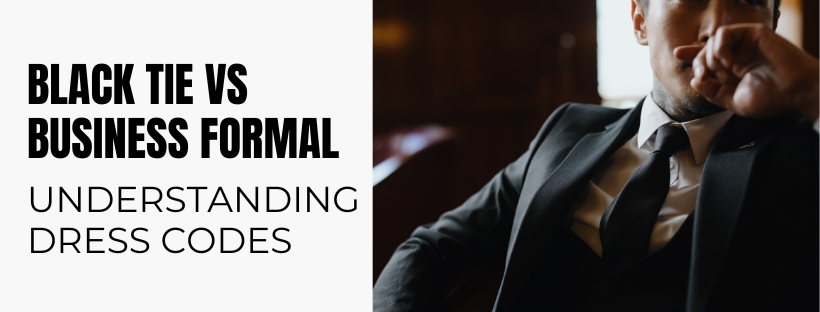
Black Tie vs Business Formal: Understanding Dress Codes
Well, you may be wrong if you think wearing a black suit matches all sets of events or occasions. Each occasion demands a dress code when it comes to men’s suits. You cannot wear the same suit for a formal, a black tie, and a casual event.
So, in this article, you’ll briefly understand the dress code of black tie and formal attire. Also, learn the main differences between these two types of attire which helps you dress up in the right style for the right occasion.
The Black tie dress code
This is a much-specified dress code that applies to the most formal, sophisticated, and refined events, like operas, formal weddings, galas, and proms. As mentioned earlier, this is a specified dress code that involves only black suits or tuxedos—to symbolize grace, elegance, and style. Even a common man can look like the most reputable gentleman among the crowd when wearing a black tie tuxedo.
Thus, fashionistas call this not just a dress code but the rule to becoming a sophisticated man in the perfect style.
Decoding the black tie attire
- Black bow tie: A satin or silk-made black bow tie is the main part of the black tie dress code.
- Black jacket and trousers: A black jacket with black silk lapels and matching tuxedo trousers (preferably in silk).
- White dress shirt: The white dress shirt that contrasts the black tux is another significant element in this refined ensemble.
- Black shoes: Ideally, black patent leather shoes for a more refined aesthetic.
- Black socks: A pair of socks—again in black—that mandatorily covers the skin and that blends with the tuxedo trousers.
- White pocket squares: This is to contrast the black tuxedo and complement the white dress shirt.
The general formal dress code
This is a dress code that applies to all formal events, including professional meetups, business events, and conferences. Unlike the black-tie dress code, this is not specified in black. Instead, this includes generic formal colors, like navy, gray, black, and charcoal. Most importantly, it does not demand a black bow tie.
Though these suits are also elegant and reserved, they are not as sophisticated as black tue suits or attires. However, both these styles are timeless formal wear—the only difference lies in the degree of formalness.
Decoding the formal attire
- Formal jackets and trousers: Formal suits—not necessarily in black, but any formal hues—navy, charcoal, or graphite gray, etc.
- White or light blue dress shirts: A dress shirt that complements or contrasts the color of the suit in the most subtle way.
- A necktie: A solid or printed necktie matching the two or three-piece ensemble.
- Oxford shoes: Sleek formal shoes, loafers, or brogues work well with any kind of formal suit and tuxedo.
- Matching accessories: Cufflinks, pocket squares, socks, watches, and belts that look professional and dignified.
Black tie Vs formal men’s attire
In simple words—black-tie attire requires a black tuxedo, a black bowtie, and a white dress shirt. On the other hand, formal attire requires no specific colors but looks entirely formal.
Conclusion
Wearing the right style for the right occasion without compromising the dress code matters the most to elevating your self-confidence levels and seeking attention and respect from your audience.
Tailor a classic black tie and business formal suit for your finest occasions with the help of the leading men’s couture in the state—Bucco!
Recent Posts

